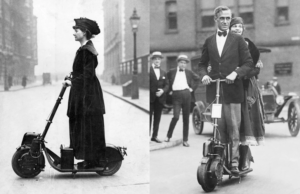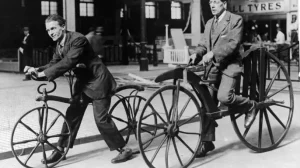The micro-mobility revolution is upon us. E-scooters and bikes are now a common sight on streets the world over. The growth in use of these forms of transport has been incredible, as more and more people choose to leave their cars behind and opt for something more sustainable for their shorter daily commutes. But what exactly is micro-mobility, and how did we get to this point?
Inspired by “World Car Free Day” which is celebrated this year on the 22nd of September, we’ve decided to take a look at the evolution of micro-mobility, and the full potential of these amazing vehicles.
Context
Our desire to continually travel further, faster and safer has led to the invention of newer, more exciting methods of transport throughout history, from camels to hover suits.
In recent years, the impact on the environment and our health of these modes of transport has made us once again rethink the way we travel. Words like “micro-mobility”, “shared transport”, “sustainable vehicles” or the “15-minute city”, are becoming part of our vocabulary as a society. Public attitude has changed, and policymakers have started to implement strategies that encourage people to shift from privately owned cars to more sustainable modes of transport. This is what led to the micro-mobility boom.
But what exactly is micro-mobility?
The definition of the term “micro-mobility” has changed and evolved over the years to include both human-powered and electric vehicles as well as docked and dockless modes of transport. Now, the term covers all small and lightweight vehicles that have a speed of up to 45 km/h. To be more specific, under the micro-mobility “umbrella” we can find everything from bikes to e-scooters and even skateboards.
The NLC identified the following distinct features between micro-mobility vehicles:
- People have more freedom to choose their own routes
- People are not dependent on a fixed schedule
- An increased number of micro-mobility vehicles require the use of a smartphone to access
- The vehicles serve individual users
- The model of share usage
To determine whether or not a vehicle falls under the micro-mobility spectrum, you can ask yourself the following questions:
- Can this vehicle surpass the speed of 45km/h?
- Does it have an internal combustion engine?
- Is this mode of transport dependent on fixed routes and schedules?
The technologies empowering micro-mobility
The evolution of transport is highly correlated with the evolution of technology and technical innovations. This is what enabled people to travel further, connect their cities and improve the quality of their life.
Among the theologies that increased the popularity of micro-mobility, we can number:
- Pedals & wheels
- Electric motors
- GPS
- Smartphones
- Batteries
- On board computers
- Electronic locks
The evolution of the top micro-mobility vehicles
In the micro-mobility world, things are constantly changing. As the way people live is evolving, the need for new and more sustainable modes of transport is also increasing. We came a long way from pedal-less vehicles, to pedalled modes of transport, and now to electric scooters and bikes that make our cities more sustainable and our daily commutes more affordable.
Share fleets are emerging all over the world and events such as the COVID-19 pandemic are propelling this revolution.

Source: eixoduro
E-scooters
For any ride on an e-scooter or an e-bike today we need to thank Benjamin Franklin and Andrew Gordon who created the electric motors and Alessandro Volta who invented the practical battery. Independent inventors from all over the world started to develop and improve their bikes, transforming them into scooters and e-bike models.
People started combining models and vehicles such as hoverboards, stand-up scooters and the modern e-scooter appeared and, in some cases, went into mass production. According to NACTO, electric scooters have been the most popular form of micro-mobility since 2018. By introducing e-scooters into the range of options, the overall number of trips jumped from 35 million in 2017 to 84 million in 2018.

Two men ride on early bicycles known as the Hobby Horse and ‘boneshaker’.
Herz/Getty Images
Bikes
Bikes represent not only one of the most used forms of micro-mobility, but one of top modes of transport in general. Although it’s hard to say how many bikes exist in the world, Bicycle Guider estimates the total number to be around 1 billion. The earliest verified bicycle is attributed to Karl von Drais who presented the design in 1818. As the term “bicycle” didn’t emerge till later (in the 1860s), the first bike was nicknamed “hobby horse”.
From the 1820s to the 1850s tricycles and quadricycles were exported all over the world and became more popular as they didn’t require the rider to be able to balance.
Although the bicycle design went through many changes over the years, the invention of pedals as well as the “safety bicycle” is what made the bike as we know it today so globally popular.
The need and enthusiasm for bikes also correlates with some important historical events such as the economic depression of 1896, World War 2, and the 1973 oil crisis among others.
Today, this sustainable, healthy and affordable mode of transport is changing the way cities look, shaping infrastructure requirements, and paving the way for other forms of micro-mobility.
The case for micro-mobility
The car was undeniably a great invention. It changed the lives of millions of people, making it easy to access new jobs, offering autonomy and opening the world to new opportunities. So why the need to change?
Today our quality of life is not influenced in such great proportion by the need to own a car. Other factors such as air quality, affordability and the fact that public institutions and facilities are available in our vicinity, make micro-mobility more desirable.
The infrastructure of cities all over the world is also changing to give the city back to the people and improve the efficiency of transport.
What can you do to travel better?
Is the car the most effective mode of transport for you? Consider a shared model of transport at least one day per week. For short commutes, you can leave your car behind and enjoy the many benefits of an e-scooter or an e-bike.
To find out more about e-scooting and micro-mobility in general, you can visit our FAQ’s page, subscribe to our blog or you can try it first hand, by downloading the app and taking your first ride today!
